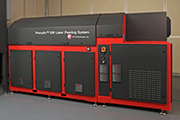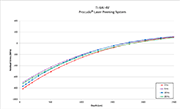E-Archive
Science Update
in Vol. 19 - January Issue - Year 2018
Optimizing Laser Peening for High-Repetition-Rate Applications

Figure 1: The diode-pumped Procudo® 200 Laser Peening System

Figure 2: Residual stress data for laser peened Ti-6Al-4V at varying pulse repetition rates
Laser shock peening (LSP) has revolutionized surface enhancement, achieving new benchmarks in metal fatigue resistance and failure prevention. The laser peening process uses high-energy pulses to produce powerful shockwaves on the surface of metal components. These mechanical shockwaves plastically deform the material, producing compressive residual stresses that reach depths previously unachievable with peening and rolling technologies.
As laser peening gained adoption with gas and steam turbine manufacturers, aerospace and power generation customers have saved millions of dollars by achieving longer service lifetimes, reduced component failures, decreased inspection requirements and reduced maintenance costs. These performance benefits validate laser peening as a cost-saving industrial application to prevent part failure caused by fatigue cracking, stress corrosion cracking, or foreign object damage.
However, despite its growing success as a shot peening alternative, laser peening has faced several barriers to widespread adoption. The material effects and component benefits have long proven cost-effective for critical aerospace parts, but comparatively high processing expenses and low throughput rates have limited applications to select, high-value components.
To reduce processing costs and expand laser peening to a broader market, LSP Technologies (LSPT) has developed an optimized production system for high-volume laser peening processing. This effort required numerous innovations to produce a high-repetition-rate laser peening system that meets the needs of OEMs around the world. Now, for the first time, LSP Technologies is presenting residual stress data from the Procudo® 200 Laser Peening System (Figure 1) operating at full power. These results demonstrate the consistency of material benefits achieved by processing at rates up to 20 Hz, establishing a new performance benchmark for this disruptive technology.
Building A More Efficient Laser
Until recently, all laser-peening systems used flashlamp-produced broadband light pulses to excite laser gain media composed of specialized glass or crystal. This process, known as "pumping", uses the "white light" energy produced by flashlamps to momentarily excite electrons in the gain medium to a higher energy level. When the electron drops back to its natural ground state, it emits a photon at a specific wavelength (i.e., the laser wavelength of the gain medium). When more electrons achieve the excited state than remain in the ground state, the system attains "population inversion" and the laser beam can be amplified.
The core liability of flashlamps is their inefficiency. Flashlamps emit a broad spectrum of white light – only a fraction of which contributes to the population inversion in the gain medium. The bulk of each flashlamp’s output is wasted as heat, and this heating of the laser rods can degrade beam quality and limit the repetition rate of the laser. For this reason, flashlamp-pumped laser peening systems typically operate at less than 50 watts average power, a constraining factor in treating large processing areas and high-volume components.
With a goal of increasing pulse rates to increase production throughput, LSPT designed the Procudo® Laser Peening System around next-generation diode-pumping technology. Diode-pumped lasers replace inefficient flashlamps with highly efficient diodes. These diodes emit a specific wavelength of light that readily excites electrons in the gain medium. With less energy loss and heat buildup in the system, diodes can be pumped more frequently to deliver laser pulses at a higher rate than current flashlamp-pumped laser peening systems.
Thanks to diode-pumping technology, the 200-Watt Procudo® LSP System outputs 10 Joules of energy per pulse at 20 Hz. Processing at this speed represents a throughput increase anywhere from 4-40 times over conventional flashlamp-pumped systems. Substantial improvements in pulse rate and system efficiency allow LSPT to reduce per-part expenses and develop high-volume applications for new parts and industries.
Processing at Speed
Advancements in laser architecture produced a system that delivers twenty high-energy pulses per second. However, laser peening at this rate presents its own set of logistical challenges that had to be overcome before 20 Hz laser peening could deliver optimized results.
Laser peening is typically performed with a part-handling robot and a series of process overlays. The robot manipulates the part within the peening cell, precisely positioning the component prior to each laser pulse. At processing rates of one or two Hz, the robot can reliably move the part through each position, pausing momentarily for laser delivery before reorienting for the next pulse. When processing at 20 Hz, this positioning methodology becomes impractical. The pulses arrive too quickly for the robot to pause at each location, and acceleration of the part can skew the spot pattern without careful coordination between the robot and the laser. To overcome this, LSPT engineers had to design new automation and controls software to reliably peen a moving target, while implementing new spot patterns and sequences for high-repetition-rate applications.
Another challenge of rapid laser peening involves maintaining the integrity of the transparent overlay. Each laser pulse generates a high-pressure plasma burst on the component surface. This expanding plasma shocks the material, sending a high-amplitude pressure wave into the part that does the work of plastic deformation. A transparent overlay, typically flowing water, is applied over the processing area to confine the expanding plasma and amplify the pressure on the material surface.
This amplification is critical for producing deep compressive residual stresses, but at high processing rates, the succession of plasma bursts can disturb the water overlay and limit material benefits. LSPT engineers again had to reconfigure a fundamental aspect of laser peening to optimize the process for speed. Maintaining overlay retention was the last logistical hurdle to effective 20 Hz processing, and it opened the door to a new era of laser peening utility.
Delivering Material Benefits
The ultimate test for the Procudo® Laser Peening System is the ability to process at both a high energy (10 J) and high repetition rate (20 Hz) while achieving residual stress profiles consistent with traditional processing benchmarks. A recent system application demonstrates the promise of this technology and the viability of high-repetition-rate, high-energy processing.
LSPT engineers laser peened samples of Ti-6AL-4V at 7 GW/cm2. Individual coupons were processed at 2 Hz, 5 Hz, 10 Hz, and 20 Hz. Residual stress measurements were acquired for each sample using the slitting method, with the resulting curves presented in Figure 2.
These results demonstrate a critical consistency between processing rates across a normalized laser peening condition. Residual stress profiles achieved via 20 Hz processing align in both magnitude and depth with those achieved at slower rates. All four conditions generated between 700-800 MPa of compressive residual stress at the surface, while maintaining a compressive profile down to more than 1.7 mm deep.
With a successful demonstration of high-repetition-rate, high-energy laser peening, LSP Technologies is laying the foundation for broader laser peening adoption around the world. The ability to effectively process at 20 Hz substantially improves throughput rates, reducing production costs, and making laser peening accessible to a growing number of industries and applications.
For Information:
LSP Technologies, Inc.
6145 Scherers Place
Dublin, Ohio 43016, USA
Tel. +1.614.718-3000 Ext. 260
E-mail: ehoffman@lspt.com



























